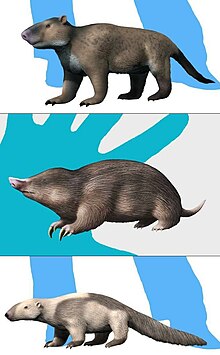Palaeanodonta ("ancient toothless animals") is an extinct clade of stem-pangolins. They were insectivorous (myrmecophagous), possibly fossorial, and lived from the middle Paleocene to early Oligocene in North America, Europe and Asia.[3][5][6] While the taxonomic grouping of Palaeanodonta has been debated,[7] it is widely thought that they are a sister group to pangolins.[8][9][5][10]
| Palaeanodonta | |
|---|---|

| |
| From top to bottom: Ernanodon antelios, Xenocranium pileorivale and Metacheiromys marshi | |
| Scientific classification | |
| Domain: | Eukaryota |
| Kingdom: | Animalia |
| Phylum: | Chordata |
| Class: | Mammalia |
| Clade: | Pholidotamorpha |
| Order: | †Palaeanodonta Matthew, 1918[1] |
| Families and genera | |
|
[see classification]
| |
| Synonyms | |
Anatomy
editSkull
editPalaeanodonts generally have low and caudally-broad skulls, with notable lambdoid crests and inflated bullae and squamosals.[3]
Teeth
editDespite the name of the group and contrary to their pangolin relatives, palaeanodonts are known to have had teeth.[11][3][10] Early palaeanodonts retained minimal tribosphenic post-canines while later species had peglike or otherwise reduced molar crowns.[11][3][10] Many also had large, characteristic cuspids.[11][10]
Classification and phylogeny
editTraditional classification
edit- Order: †Palaeanodonta (Matthew, 1918) (stem-pangolins)[3]
- Family: †Epoicotheriidae (paraphyletic family) (Simpson, 1927)
- Family: †Escavadodontidae (Rose & Lucas, 2000)
- Family: †Metacheiromyidae (Wortman, 1903)
- Incertae sedis:
- Genus: †Arcticanodon (Rose, 2004)
- Genus: †Melaniella (Fox, 1984)
Revised classification
edit- Order: †Palaeanodonta (Matthew, 1918) (stem-pangolins)[6]
- Family: †Epoicotheriidae (paraphyletic family) (Simpson, 1927)
- Genus: †Alocodontulum (Rose, 1978)
- †Alocodontulum atopum (Rose, 1977)
- Genus: †Amelotabes (Rose, 1978)
- †Amelotabes simpsoni (Rose, 1978)
- Genus: †Auroratherium (Tong & Wang, 1997)
- †Auroratherium sinense (Tong & Wang, 1997)
- Genus: †Dipassalus (Rose, 1991)
- †Dipassalus oryctes (Rose, 1991)
- Genus: †Tubulodon (Jepsen, 1932)
- †Tubulodon taylori (Jepsen, 1932)
- Subfamily: †Epoicotheriinae (paraphyletic subfamily) (Simpson, 1927)
- Genus: †Pentapassalus (Gazin, 1952)
- †Pentapassalus pearcei (Gazin, 1952)
- †Pentapassalus woodi (Guthrie, 1967)
- Genus: †Tetrapassalus (Simpson, 1959)
- †Tetrapassalus mckennai (Simpson, 1959)
- †Tetrapassalus proius (West, 1973)
- †Tetrapassalus sp. A [AMNH 10215] (Rose, 1978)
- †Tetrapassalus sp. B (Robinson, 1963)
- (unranked): †Epoicotherium/Xenocranium clade
- Genus: †Epoicotherium (Simpson, 1927)
- †Epoicotherium unicum (Douglass, 1905)
- Genus: †Molaetherium (Storch & Rummel, 1999)
- †Molaetherium heissigi (Storch & Rummel, 1999)
- Genus: †Xenocranium (Colbert, 1942)
- †Xenocranium pileorivale (Colbert, 1942)
- Genus: †Epoicotherium (Simpson, 1927)
- Genus: †Pentapassalus (Gazin, 1952)
- Genus: †Alocodontulum (Rose, 1978)
- Family: †Ernanodontidae (Ting, 1979)
- Genus: †Asiabradypus (Nessov, 1987)
- †Asiabradypus incompositus (Nessov, 1987)
- Genus: †Ernanodon (Ting, 1979)
- †Ernanodon antelios (Ting, 1979)
- Genus: †Asiabradypus (Nessov, 1987)
- Family: †Escavadodontidae (Rose & Lucas, 2000)
- Genus: †Escavadodon (Rose & Lucas, 2000)
- †Escavadodon zygus (Rose & Lucas, 2000)
- Genus: †Escavadodon (Rose & Lucas, 2000)
- Family: †Metacheiromyidae (paraphyletic family)[6] (Wortman, 1903)
- Genus: †Brachianodon (Gunnell & Gingerich, 1993)
- †Brachianodon westorum (Gunnell & Gingerich, 1993)
- Genus: †Mylanodon (Secord, 2002)
- †Mylanodon rosei (Secord, 2002)
- Subfamily: †Metacheiromyinae (paraphyletic subfamily)[6] (Wortman, 1903)
- Genus: †Metacheiromys (Wortman, 1903)
- †Metacheiromys dasypus (Osborn, 1904)
- †Metacheiromys marshi (Wortman, 1903)
- Genus: †Palaeanodon (Matthew, 1918)
- †Palaeanodon ignavus (Matthew, 1918)
- †Palaeanodon nievelti (Gingerich, 1989)
- †Palaeanodon parvulus (Matthew, 1918)
- †Palaeanodon sp. [Le Quesnoy] (Gheerbrant, 2005)
- Genus: †Metacheiromys (Wortman, 1903)
- Subfamily: †Propalaeanodontinae (Schoch, 1984)
- Genus: †Propalaeanodon (Rose, 1979)
- †Palaeanodon parvulus (Rose, 1979)
- Genus: †Propalaeanodon (Rose, 1979)
- Genus: †Brachianodon (Gunnell & Gingerich, 1993)
- Incertae sedis:
- Genus: †Arcticanodon (Rose, 2004)
- †Arcticanodon dawsonae (Rose, 2004)
- Genus: †Melaniella (Fox, 1984)
- †Melaniella timosa (Fox, 1984)
- Genus: †Arcticanodon (Rose, 2004)
- Family: †Epoicotheriidae (paraphyletic family) (Simpson, 1927)
Phylogenetic tree
editThe phylogenetic relationships of order Palaeanodonta are shown in the following cladogram:[3][5][6]
| Ferae |
|
†Epoicotherium/Xenocranium clade | |||||||||||||||||||||
See also
editReferences
edit- ^ W. D. Matthew (1918.) "A revision of the Lower Eocene Wasatch and Wind River faunas. Part V. Insectivora (Continued), Glires, Edentata." Bulletin of the American Museum of Natural History 38(16):429-483
- ^ Kenneth E. Kinman (1994.) "The Kinman system: toward a stable cladisto-eclectic classification of organisms: living and extinct, 48 phyla, 269 classes, 1,719 orders"
- ^ a b c d e f g Rose, K. D. (2008). "9. Palaeanodonta and Pholidota". In Janis, C. M.; Gunnell, G. F.; Uhen, M. D. (eds.). Evolution of Tertiary Mammals of North America. Cambridge University Press. pp. 135–146. doi:10.1017/CBO9780511541438.010.
- ^ Arthur Sperry Pearse (1936.) "Zoological names. A list of phyla, classes, and orders, prepared for section F, American Association for the Advancement of Science" American Association for the Advancement of Science
- ^ a b c Gaudin, T. J.; Emry, R. J.; Wible, J. R. (2009). "The Phylogeny of Living and Extinct Pangolins (Mammalia, Pholidota) and Associated Taxa: A Morphology Based Analysis". Journal of Mammalian Evolution. 16: 235. doi:10.1007/s10914-009-9119-9.
- ^ a b c d e Kondrashov, Peter; Agadjanian, Alexandre K. (2012). "A nearly complete skeleton of Ernanodon (Mammalia, Palaeanodonta) from Mongolia: morphofunctional analysis". Journal of Vertebrate Paleontology. 32 (5): 983–1001. doi:10.1080/02724634.2012.694319. ISSN 0272-4634.
- ^ Averianov, A. O. & Lopatin, A. V. (2014.) "High-level systematics of placental mammals: Current status of the problem." Biology Bulletin, 41(9), 801–816.
- ^ McKenna, M. C.; Bell, S. K. (1997). Classification of Mammals: Above the Species Level. Columbia University Press. pp. 220–221. ISBN 978-0-231-52853-5.
- ^ Rose, K. D.; Emry, R. J.; Gaudin, T. J.; Storch, G. (2005). "Xenarthra and Pholidota". In Rose, K. D.; Archibald, J. D. (eds.). The Rise of Placental Mammals. Origins and Relationships of the Major Extant Clades. Johns Hopkins University Press. pp. 106–126. ISBN 978-0-8018-8022-3.
- ^ a b c d Ungar, P. S. (2010). "Cenozoic Mammal Evolution". Mammal Teeth: Origin, Evolution, and Diversity. pp. 110–126. ISBN 978-0-8018-9668-2.
- ^ a b c Rose, K. D.; Lucas, S. G. (2000). "An early Paleocene palaeanodont (Mammalia, ?Pholidota) from New Mexico, and the origin of Palaeanodonta". Journal of Vertebrate Paleontology. 20 (1): 139–156. doi:10.1671/0272-4634(2000)020[0139:AEPPMP]2.0.CO;2.